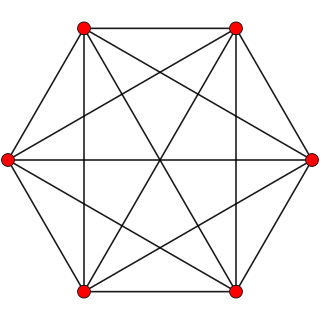 W
WIn five-dimensional geometry, a five-dimensional polytope or 5-polytope is a 5-dimensional polytope, bounded by (4-polytope) facets. Each polyhedral cell being shared by exactly two 4-polytope facets.
 W
WIn five-dimensional geometry, a demipenteract or 5-demicube is a semiregular 5-polytope, constructed from a 5-hypercube (penteract) with alternated vertices removed.
 W
WIn five-dimensional geometry, a 5-orthoplex, or 5-cross polytope, is a five-dimensional polytope with 10 vertices, 40 edges, 80 triangle faces, 80 tetrahedron cells, 32 5-cell 4-faces.
 W
WIn four-dimensional Euclidean geometry, the 24-cell honeycomb, or icositetrachoric honeycomb is a regular space-filling tessellation of 4-dimensional Euclidean space by regular 24-cells. It can be represented by Schläfli symbol {3,4,3,3}.
 W
WIn 5-dimensional geometry, there are 19 uniform polytopes with A5 symmetry. There is one self-dual regular form, the 5-simplex with 6 vertices.
 W
WIn 5-dimensional geometry, there are 31 uniform polytopes with B5 symmetry. There are two regular forms, the 5-orthoplex, and 5-cube with 10 and 32 vertices respectively. The 5-demicube is added as an alternation of the 5-cube.
 W
WIn four-dimensional Euclidean geometry, the birectified 16-cell honeycomb is a uniform space-filling tessellation in Euclidean 4-space.
 W
WIn six-dimensional geometry, a cantellated 5-cube is a convex uniform 5-polytope, being a cantellation of the regular 5-cube.
 W
WIn five-dimensional geometry, a cantellated 5-orthoplex is a convex uniform 5-polytope, being a cantellation of the regular 5-orthoplex.
 W
WIn five-dimensional geometry, a cantellated 5-simplex is a convex uniform 5-polytope, being a cantellation of the regular 5-simplex.
 W
WIn geometry of five dimensions or higher, a cantic 5-cube, cantihalf 5-cube, truncated 5-demicube is a uniform 5-polytope, being a truncation of the 5-demicube. It has half the vertices of a cantellated 5-cube.
 W
WIn 5-dimensional geometry, there are 23 uniform polytopes with D5 symmetry, 8 are unique, and 15 are shared with the B5 symmetry. There are two special forms, the 5-orthoplex, and 5-demicube with 10 and 16 vertices respectively.
 W
WIn four-dimensional Euclidean geometry, the 16-cell honeycomb is one of the three regular space-filling tessellations, represented by Schläfli symbol {3,3,4,3}, and constructed by a 4-dimensional packing of 16-cell facets, three around every face.
 W
WIn five-dimensional geometry, a rectified 5-cube is a convex uniform 5-polytope, being a rectification of the regular 5-cube.
 W
WIn five-dimensional geometry, a rectified 5-orthoplex is a convex uniform 5-polytope, being a rectification of the regular 5-orthoplex.
 W
WIn five-dimensional geometry, a rectified 5-simplex is a convex uniform 5-polytope, being a rectification of the regular 5-simplex.
 W
WIn six-dimensional geometry, a runcic 5-cube or is a convex uniform 5-polytope. There are 2 runcic forms for the 5-cube. Runcic 5-cubes have half the vertices of runcinated 5-cubes.
 W
WIn five-dimensional geometry, a runcinated 5-cube is a convex uniform 5-polytope that is a runcination of the regular 5-cube.
 W
WIn five-dimensional geometry, a runcinated 5-orthoplex is a convex uniform 5-polytope with 3rd order truncation (runcination) of the regular 5-orthoplex.
 W
WIn six-dimensional geometry, a runcinated 5-simplex is a convex uniform 5-polytope with 3rd order truncations (Runcination) of the regular 5-simplex.
 W
WIn five-dimensional geometry, a steric 5-cube or is a convex uniform 5-polytope. There are unique 4 steric forms of the 5-cube. Steric 5-cubes have half the vertices of stericated 5-cubes.
 W
WIn five-dimensional geometry, a stericated 5-cube is a convex uniform 5-polytope with fourth-order truncations (sterication) of the regular 5-cube.
 W
WIn five-dimensional geometry, a stericated 5-simplex is a convex uniform 5-polytope with fourth-order truncations (sterication) of the regular 5-simplex.
 W
WIn four-dimensional euclidean geometry, the tesseractic honeycomb is one of the three regular space-filling tessellations, represented by Schläfli symbol {4,3,3,4}, and constructed by a 4-dimensional packing of tesseract facets.
 W
WIn five-dimensional geometry, a truncated 5-cube is a convex uniform 5-polytope, being a truncation of the regular 5-cube.
 W
WIn six-dimensional geometry, a truncated 5-orthoplex is a convex uniform 5-polytope, being a truncation of the regular 5-orthoplex.
 W
WIn five-dimensional geometry, a truncated 5-simplex is a convex uniform 5-polytope, being a truncation of the regular 5-simplex.
 W
WIn geometry, a uniform 5-polytope is a five-dimensional uniform polytope. By definition, a uniform 5-polytope is vertex-transitive and constructed from uniform 4-polytope facets.